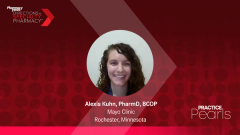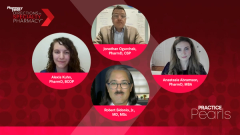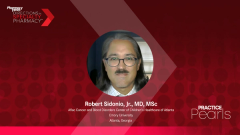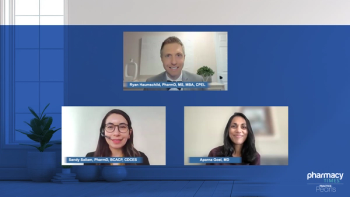
Reflections on the Evolving Space of Prophylaxis in Hemophilia A
A panel of experts share their final thoughts on the role of prophylaxis in hemophilia A and the importance of shared decision making and education.
Episodes in this series

Jonathan Ogurchak, PharmD, CSP: I’d like to just kind of open it up, and I’ll look with each of you on the panel here. I want to get some final thoughts. We’ve talked about a lot over the last more than several minutes at this point, as it relates to this role of prophylaxis in hemophilia A. Just want to get some of your parting thoughts from each of you moving forward with this. Dr. Sidonio, if you wouldn’t mind getting started.
Robert Sidonio, Jr., MD, MSc: I’ll get started. Obviously, what I’ve learned in my brief career in hemophilia is patients really like choice. We’re really blessed to be able to have so many different options. At times, sometimes it feels like a curse because there are so many products in this space. But what I’ve learned is that patients are individuals, not every single person’s going to respond to the same product, and I think we’re lucky to have so many good products. We’re lucky to have had so much—a good research infrastructure that’s really supported by this HTC [hemophilia treatment center] network that was established after the devastating effects of blood product contamination in the early 1980s. Thus, we’re benefiting from that, building from that, and obviously ensuring that we don’t have any more of those tragedies. It really is a nice network of people that really care about these patients. I enjoy the interactions with the patient community and try to make sure we’re factoring in some of those issues, make sure that marginalized patients are heard. But moving forward, we have so many great options for prophylaxis. We’re obviously instituting it earlier and earlier and we have newer products that allow us to institute it earlier, and we may be at a point in the next 5 to 10 years where we rarely have these life-threatening bleeding events, certainly hopefully avoiding the devastating intracranial hemorrhages that in children that have lifelong effects.
Jonathan Ogurchak, PharmD, CSP: Dr. Kuhn, I’ll hand it over to you for some final thoughts.
Alexis Kuhn, PharmD, BCOP: To amplify what Dr. Sidonio was saying, this is a prime example of an individualized disease state, that the shared decision making between the providers and the patients is absolutely essential here. As we’ve established, there are plenty of burdens that are associated with prophylactic therapy, but tons of benefits that are realized over the lifetime of these kids with lifelong diseases. Thus, if you can work with the family to really establish shared goals and how are we going to achieve this, whether it’s with clotting factor concentrates that are IV [intravenous] or with a subcutaneous option, or in 5 years from now, if we’ve got other therapies that we can offer, but we are really looking to work with the family and determine what is best for them. I love working in hemophilia and I am really kind of amplifying the fact that this is a shared decision-making situation. It’s fun to work with families and teams and really be a part of a collaborative experience.
Jonathan Ogurchak, PharmD, CSP: Dr. Abramson, some parting thoughts?
Anastasia Abramson, PharmD, MBA: Sure. Definitely agree with both Dr. Kuhn and Sidonio. I think within specialty pharmacy, we are just in such a unique and prime position to bring home that education piece for the patients. Of course, they do really get great education when they are being placed onto these therapies and participating in making that decision, but continued education and that continued communication and assessment throughout the duration of their therapy, especially with prophylaxis, is really important. Ten years ago when they were put onto prophylaxis, the barriers that maybe they had then are different from today, and will continue evolving, especially as we look at our pediatric populations that are then heading into say college or they’re heading into their late 20s, early 30s, they are gaining independence and really trying to navigate taking responsibility of their own health maybe for the first time since they’ve left home, and we can see that become an issue with maintaining on therapy. Thus, just making sure that we’re there for both the education, the reminder of what the long game is, but also offering support wherever possible, whether that’s helping to tweak some administration difficulties, or helping identify assistance with access, copay assistance, that sort of thing is key. But again, we’re just there to kind of remove the barriers to ensure that they have a successful therapy and positive outcomes.
Jonathan Ogurchak, PharmD, CSP: Thank you very much, and thank you to our esteemed panelists, Dr. Sidonio, Dr. Kuhn, and Dr. Abramson, for not only joining us today and providing your insight on the role of prophylaxis for hemophilia A but for all that you do on a day-to-day basis in helping to take care of these patients and their families. It’s really a testament to the hemophilia community for the things that you’re able to provide, so thank you for that and all that you can do. To our viewing audience as well, we really hope that you found that this Directions in Specialty Pharmacy Practice Pearls event was very rich and informative as it relates to hemophilia, and we appreciate you joining us today.
Transcripts edited for clarity.
Newsletter
Stay informed on drug updates, treatment guidelines, and pharmacy practice trends—subscribe to Pharmacy Times for weekly clinical insights.




















































































































































































































